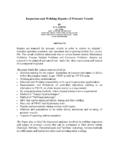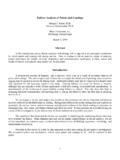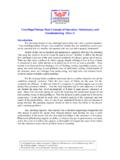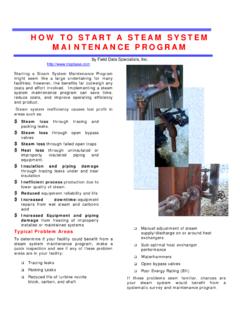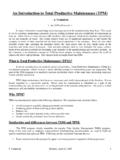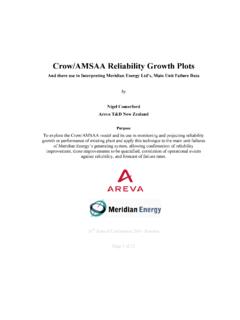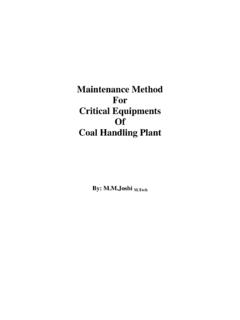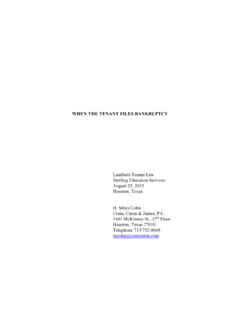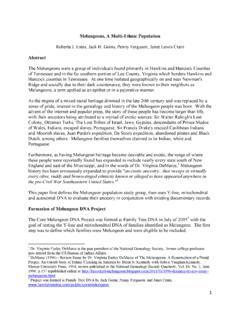Transcription of The Role of CMMS - plant-maintenance.com
1 The Role of CMMS. A white paper on the selection and implementation of computerized maintenance management systems Prepared by: Mike Crain Manager, Industrial Technologies Northern Digital, Inc. The Role of CMMS. Computerized Maintenance Management Systems (CMMS) have evolved over the last three decades from elementary asset tracking and preventive maintenance functionality, to enterprise maintenance information systems. There are hundreds of vendors providing solutions on a variety of platforms. These best of breed systems provide users comprehensive functionality to facilitate the flow of maintenance information and the ability to check the health of the maintenance organization at a glance.
2 As the maintenance, repair and operations (MRO) software market continues to expand vendors have developed solutions that focus on specific segments of asset and work management. Systems described as enterprise asset management (EAM), asset life cycle management, asset performance management, asset or enterprise reliability management and condition monitoring are all focused on achieving the same goal; increasing equipment availability and performance, increasing product quality and reducing maintenance expense. When a CMMS is implemented to facilitate established process and standards those goals can be realized. Does your organization need a CMMS?
3 The vendor hype surrounding business software is only rivaled by the number of unsuccessful implementations, maintenance management software is no exception. If you are considering taking on a maintenance management implementation, first identify the goals and vision of the maintenance department. If you just want a list of assets and parts for accounting, CMMS is overkill. On the other hand, if your goal is to reduce unproductive time spent going through filing cabinets trying to answer questions like: When was the last time we worked on this asset? And what was the problem? Where did we buy this part last time? Who has their phone number? Is there a substitute part in the storeroom?
4 Where is it? Is this equipment under warranty? Have we performed the required warranty maintenance task? How much have all the repairs on this asset cost? Should we replace it? When was the last time a part was used? Is it obsolete? What did we spend on preventive maintenance last year? Reactive? If those questions sound familiar you probably could benefit from a CMMS. Process First Far too often organizations will purchase CMMS or EAM software with the expectation that their maintenance business will instantly operate more efficiently. As with everything else in life, CMMS can only provide to you what you put into it. By defining and documenting existing process, requirements and establishing a method for measuring performance your team will define the role of the CMMS and what functionality is required to fulfill the maintenance vision.
5 Your maintenance department has several basic processes, from purchasing inventory for a planned maintenance activity to an emergency breakdown work request. Establish a team that represents all facets of the maintenance organization (planning, storeroom, purchasing, engineering, etc). Diagram existing processes and determine possible bottle necks that can be eliminated and parts of the process that can be automated. Example maintenance processes include: Reactive or corrective work (with and without materials). Planned maintenance (with and without materials). Preventive maintenance (with and without materials). Engineering / maintenance projects MRO parts reorder MRO parts cycle count MRO parts receiving It is a good idea to establish a continuous process improvement team to evaluate and add maintenance processes on a fixed basis, such as quarterly.
6 1. The Role of CMMS. Measuring the Process To evaluate the success of maintenance processes and your implementation as a whole, key performance indicator's (KPI's) need to be defined. The KPI's will allow your team to identify and further optimize the business processes, determine training requirements and quantify the return on investment. Common measurements include: Planned vs. reactive maintenance (cost and hours). Percent preventive of planned (cost and hours). Percent project of planned (cost and hours). Percent predictive of planned (cost and hours). Backlog (cost and hours). Inventory turns Maintenance cost as a percentage of equipment replacement cost Cost by equipment class Schedule compliance Percent equipment availability Loss opportunity due to equipment failure Loss opportunity due to equipment preventive maintenance Requirements Definition Once the primary processes and measurements are defined the actual information requirements need to be determined.
7 Identify what data is required, and what is nice to have . Evaluate how labor is scheduled and cost is tracked. Determine the types of work orders and how they will be prioritized. Determine what types of analysis will be performed, and what supporting data is required. Develop standard nomenclature for items such as locations, assets, bins and parts. Identify what entities you are going to track, and what information needs to be tracked for each. Evaluate the information requirements for other systems. Will an interface be required to accounting, HR, timekeeping, purchasing or project management software? Will other specialty systems need to be integrated such as control and condition monitoring software?
8 Identify requirements from your IT. department regarding preferred operating system and database platforms. Does IT want a web or client server deployment? All these requirements should be documented as a formal functional requirements document. Take this opportunity to review your organization chart. Are positions defined in the work process filled? Possibly a full time maintenance planner needs to be added or additional storeroom personnel. Are job descriptions modified to incorporate process requirements? Who will be responsible for supporting users from the maintenance group and from IT? Common Components of a CMMS. Once your requirements have been defined, a checklist can be compiled to rate the functionality of systems you are evaluating.
9 Most CMMS applications are comprised of baseline modules that support basic maintenance functions of asset management, work management, preventive maintenance and materials management. Some applications have add-on modules available for additional cost that address specialty requirements such as fleet, mobile work order, barcode, and work request. The following lists common modules and specific fields and functionality found in most CMMS. applications. Labor The ability to keep a listing of employees The ability to assign an employee to a and certifications specific crew and / or shift The ability to assign an employee to a The ability to assign standard and overtime specific craft rates to an employee 2.
10 The Role of CMMS. Asset Nameplate data (manufacturer, model, Cost codes serial) Asset cost Asset criticality Warranty information Material list Meters (used to trigger PM's). Location or position Safety procedures Hierarchy for rolling up cost from the asset The ability to attach documents or images to area and facility that can be printed with the work order Asset assemblies User defined fields Configurable equipment class and / or type Work Management Work order number The ability to plan crafts, shifts and Work order description employees on work orders Work order priority The ability to record the assets downtime Configurable work order type (PM, Record planned vs.)
